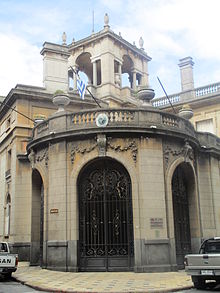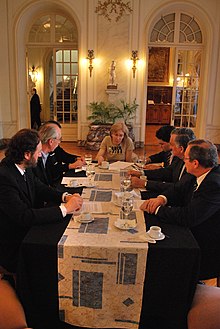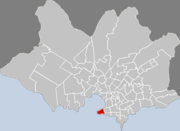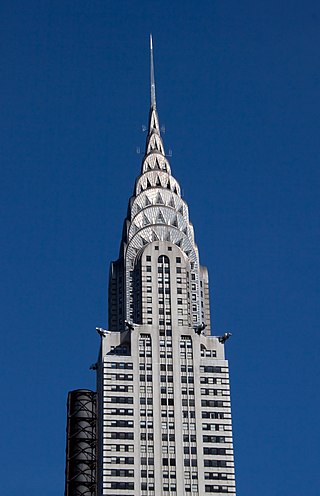
Art Deco, short for the French Arts Décoratifs, and sometimes referred to simply as Deco, is a style of visual arts, architecture, and product design, that first appeared in France in the 1910s, and flourished in the United States and Europe during the 1920s to early 1930s. Through styling and design of the exterior and interior of anything from large structures to small objects, including how people look, Art Deco has influenced bridges, buildings, ships, ocean liners, trains, cars, trucks, buses, furniture, and everyday objects like radios and vacuum cleaners.
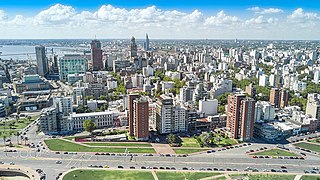
Montevideo is the capital and largest city of Uruguay. According to the 2011 census, the city proper has a population of 1,319,108 in an area of 201 square kilometers (78 sq mi). Montevideo is situated on the southern coast of the country, on the northeastern bank of the Río de la Plata.

Art Nouveau is an international style of art, architecture, and applied art, especially the decorative arts. It was often inspired by natural forms such as the sinuous curves of plants and flowers. Other characteristics of Art Nouveau were a sense of dynamism and movement, often given by asymmetry or whiplash lines, and the use of modern materials, particularly iron, glass, ceramics and later concrete, to create unusual forms and larger open spaces. It was popular between 1890 and 1910 during the Belle Époque period, and was a reaction against the academic art, eclecticism and historicism of 19th century architecture and decoration.

The Palacio de Bellas Artes is a prominent cultural center in Mexico City. It has hosted notable events in music, dance, theatre, opera and literature in Mexico and has held important exhibitions of painting, sculpture and photography. Consequently, the Palacio de Bellas Artes has been called the "Cathedral of Art in Mexico". The building is located on the western side of the historic center of Mexico City next to the Alameda Central park.
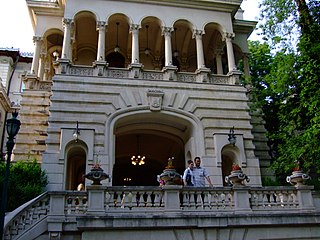
Cotroceni Palace is the official residence of the President of Romania. It is located at Bulevardul Geniului, nr. 1, in Bucharest, Romania. The palace also houses the National Cotroceni Museum.
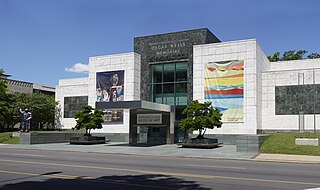
The Birmingham Museum of Art is a museum in Birmingham, Alabama. Its collection includes more than 24,000 paintings, sculptures, prints, drawings, and decorative arts representing various cultures, including Asian, European, American, African, Pre-Columbian, and Native American. The museum is also home to some Renaissance and Baroque paintings, sculptures,and decorative arts from the late 13th century to c. 1750.

The Bavarian National Museum in Munich is one of the most important museums of decorative arts in Europe and one of the largest art museums in Germany. Since the beginning the collection has been divided into two main groups: the art historical collection and the folklore collection.
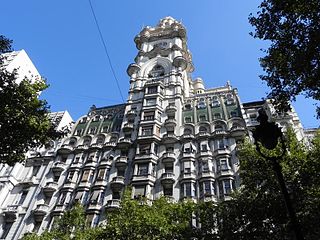
Palacio Barolo is a landmark office building, located at 1370 Avenida de Mayo, in the neighborhood of Montserrat, Buenos Aires, Argentina. It stood as Buenos Aires' tallest building for more than a decade until the construction of the Kavanagh Building in 1936. Its twin brother, Palacio Salvo, is a building designed and erected in Eclectic style, built by the same architect in Montevideo.

Ciudad Vieja is a historic neighbourhood in Montevideo, the capital of Uruguay. Located in a peninsula at the entrance of the natural port of Montevideo it was founded in 1724 as a walled city by the Spanish Empire, after the independence of Uruguay the city rapidly grew outwards and the Ciudad Vieja remained as one of the central neighbourhoods, nowadays it serves as one of the main office districts of Montevideo, housing multiple banks and institutions, but also as one of the main tourist attractions in Uruguay due to its historical significance and classical architecture.

The Museum of Art, Rhode Island School of Design is an art museum integrated with the Rhode Island School of Design, in Providence, Rhode Island, US. The museum was co-founded with the school in 1877. It is the 20th-largest art museum in the United States, and has seven curatorial departments.

The Estévez Palace is a building situated in Plaza Independencia, Montevideo, Uruguay, designed in a combination of Doric and Colonial styles by Manoel de Castel in 1873. It has served as the working place of the President of Uruguay and has been eventually converted to a museum, housing artifacts and mementos of the Uruguayan presidency and its office holders.

The Legislative Palace of Uruguay is a monumental building, meeting place of the General Assembly of Uruguay, and the seat of the legislative branch of the Uruguayan government. It is located in the barrio of Aguada in the city of Montevideo.

The National Museum of Decorative Arts is an art museum in Recoleta, Buenos Aires, Argentina.
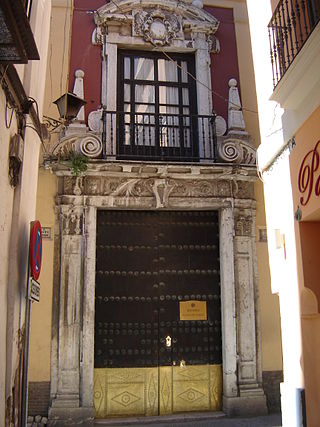
The Lebrija Palace or Palacio de la Condesa de Lebrija is a house-museum in central Seville, Spain. Dating to the 16th century and remodeled between the 18th and 20th centuries, the palace is characterised by its collection of art, including Roman mosaics and other antiquities as well as Asian art, paintings by European masters and European decorative arts.

The Liria Palace is a neoclassical palace in Madrid, Spain. It is the Madrid residence of the Dukes of Alba.
Román Fresnedo Siri was a Uruguayan architect.
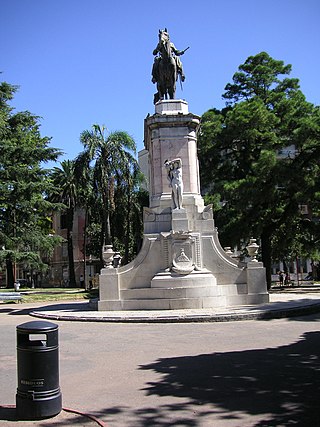
Plaza Zabala is a plaza in the Ciudad Vieja of Montevideo, Uruguay. In late 1878, during the dictatorship of Colonel Lorenzo Latorre, it was decided to demolish the old fort and build a public square in its place. But for 12 years this site remained a wasteland. The Plaza finally came to be established only on December 31, 1890 when the equestrian statue of Bruno Mauricio de Zabala was installed. It was sculpted by the Spanish sculptor Lorenzo Coullaut Valera in collaboration with the Basque architect Pedro Muguruza Otaño and inaugurated on December 27, 1931.

The Museu de les Arts Decoratives, in English Decorative Arts Museum, is a museum opened on 1932 and located in the Palau Reial de Pedralbes in Barcelona. Created in 1932, this historic museum contains a rich and diverse collection of European decorative arts, from the Middle Ages to the Industrial Revolution. In 1995, the museum extended its boundaries with the incorporation of design, thus converting it into the first and only statewide museum concerned with the preservation and exhibition of Spanish industrial design. The collections of the Museu de les Arts Decoratives were created from an important resource of industrial design and decorative art objects, that included salvers, carriages, furniture, wallpaper, clocks, tapestries and glasswork.

The National Museum of Ceramics and Decorative Arts "González Martí", located in Valencia, Spain, is a museum dedicated to ceramics, porcelains and other decorative arts such as textile art, traditional costumes and furniture.
